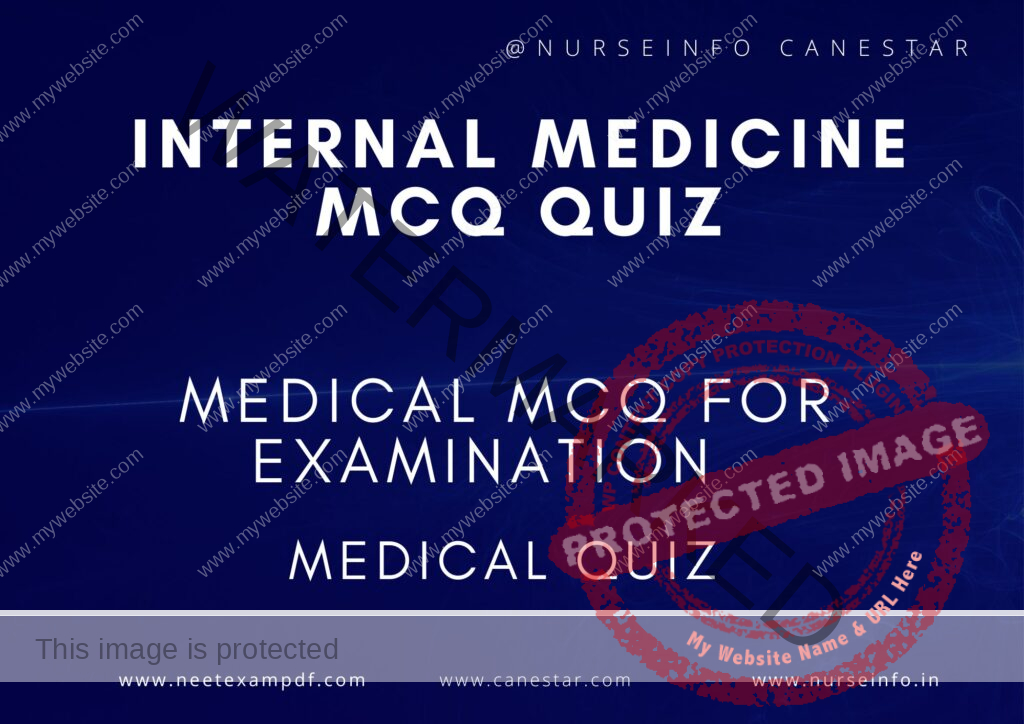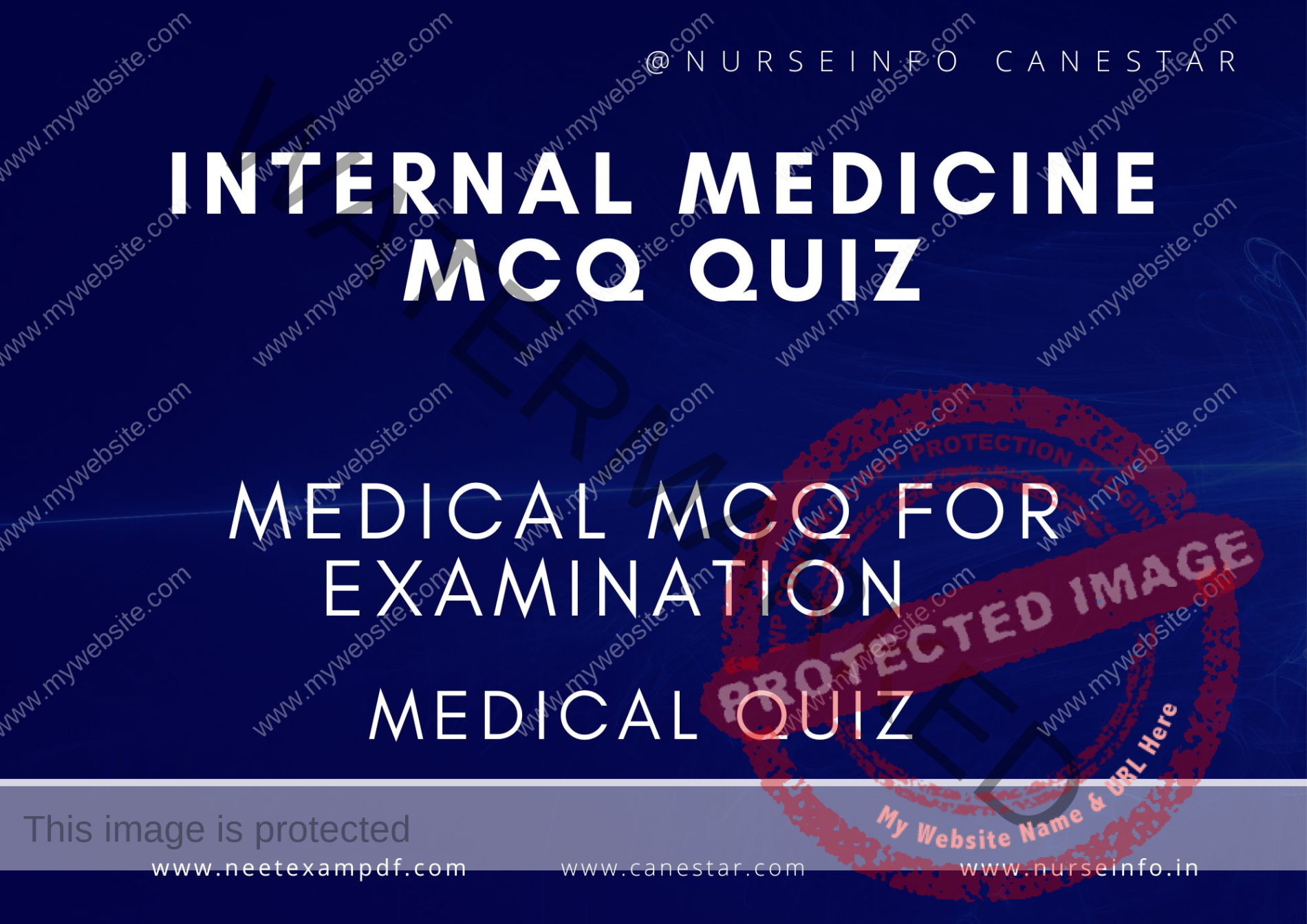MULTIPLE CHOICE QUESTIONS ON INTERNAL MEDICINE PRACTICE QUIZ – MCQS WITH RATIONALE ANSWER – INTERNAL MEDICINE MCQ QUESTIONS WITH RATIONALE
MCQ FOR INTERNAL MEDICINE QUIZ
These mcqs are prepared exclusively for medical professionals for exam preparation. MCQ is helpful to remember the concept on internal medicine mcq quiz. This multiple choice questions are helpful for preparation for DHA, PROMETRIC, MOH, HAAD, NCLEX, Medical, NEET and Nursing EXAMINATION
INTERNAL MEDICINE MCQ QUIZ
1. Which of the following is the most common cause of chronic kidney disease in the United States?
A) Hypertension
B) Diabetes mellitus
C) Glomerulonephritis
D) Polycystic kidney disease
Answer: B) Diabetes mellitus
Rationale: Diabetes mellitus is the most common cause of chronic kidney disease in the United States due to the damage high blood sugar levels cause to the kidneys over time.
2. What is the first-line treatment for Helicobacter pylori infection?
A) Proton pump inhibitor (PPI) monotherapy
B) Amoxicillin and clarithromycin
C) PPI, amoxicillin, and clarithromycin
D) Metronidazole and tetracycline
Answer: C) PPI, amoxicillin, and clarithromycin
Rationale: The first-line treatment for Helicobacter pylori infection typically involves a combination therapy of a proton pump inhibitor (PPI) and two antibiotics, usually amoxicillin and clarithromycin, to eradicate the infection.
3. Which of the following is a major risk factor for the development of hepatocellular carcinoma?
A) Chronic hepatitis C infection
B) Alcoholic liver disease
C) Non-alcoholic fatty liver disease
D) All of the above
Answer: D) All of the above
Rationale: Chronic hepatitis C infection, alcoholic liver disease, and non-alcoholic fatty liver disease are all major risk factors for the development of hepatocellular carcinoma due to their roles in causing chronic liver damage and cirrhosis.
4. What is the recommended treatment for an acute exacerbation of chronic obstructive pulmonary disease (COPD)?
A) Inhaled corticosteroids
B) Long-acting beta-agonists
C) Short-acting bronchodilators and systemic corticosteroids
D) Leukotriene receptor antagonists
Answer: C) Short-acting bronchodilators and systemic corticosteroids
Rationale: An acute exacerbation of COPD is typically treated with short-acting bronchodilators to relieve bronchospasm and systemic corticosteroids to reduce inflammation.
5. Which of the following conditions is associated with the “pigeon chest” deformity?
A) Marfan syndrome
B) Rickets
C) Osteogenesis imperfecta
D) Paget’s disease of bone
Answer: B) Rickets
Rationale: Rickets, a condition caused by vitamin D deficiency, is associated with “pigeon chest” (pectus carinatum) deformity due to impaired mineralization of the rib cartilage.
6. What is the most common cause of upper gastrointestinal bleeding?
A) Peptic ulcer disease
B) Esophageal varices
C) Gastric cancer
D) Mallory-Weiss tear
Answer: A) Peptic ulcer disease
Rationale: Peptic ulcer disease is the most common cause of upper gastrointestinal bleeding, typically presenting with hematemesis or melena.
7. Which of the following is the hallmark sign of Addison’s disease?
A) Hyperglycemia
B) Hypertension
C) Hyperpigmentation
D) Hypernatremia
Answer: C) Hyperpigmentation
Rationale: Hyperpigmentation, especially in areas exposed to friction, is a hallmark sign of Addison’s disease due to elevated levels of adrenocorticotropic hormone (ACTH).
8. What is the initial treatment for a patient presenting with suspected acute coronary syndrome?
A) Nitroglycerin
B) Beta-blockers
C) Aspirin
D) ACE inhibitors
Answer: C) Aspirin
Rationale: Aspirin is given immediately to patients with suspected acute coronary syndrome to inhibit platelet aggregation and reduce the risk of further clot formation.
9. Which of the following is a common complication of type 2 diabetes mellitus?
A) Diabetic ketoacidosis
B) Hypoglycemia
C) Hyperosmolar hyperglycemic state
D) Hyperparathyroidism
Answer: C) Hyperosmolar hyperglycemic state
Rationale: Hyperosmolar hyperglycemic state is a serious complication of type 2 diabetes mellitus characterized by extremely high blood glucose levels without significant ketosis.
10. Which laboratory test is most specific for diagnosing rheumatoid arthritis?
A) Antinuclear antibody (ANA)
B) Rheumatoid factor (RF)
C) Anti-cyclic citrullinated peptide (anti-CCP)
D) Erythrocyte sedimentation rate (ESR)
Answer: C) Anti-cyclic citrullinated peptide (anti-CCP)
Rationale: Anti-cyclic citrullinated peptide (anti-CCP) antibodies are highly specific for rheumatoid arthritis and are useful in the early diagnosis of the disease.
11. What is the preferred diagnostic test for pulmonary embolism?
A) Chest X-ray
B) Ventilation-perfusion (V/Q) scan
C) D-dimer test
D) Computed tomography pulmonary angiography (CTPA)
Answer: D) Computed tomography pulmonary angiography (CTPA)
Rationale: Computed tomography pulmonary angiography (CTPA) is the preferred diagnostic test for pulmonary embolism due to its high sensitivity and specificity.
12. Which of the following is a characteristic feature of Cushing’s syndrome?
A) Weight loss
B) Hypotension
C) Hyperpigmentation
D) Central obesity
Answer: D) Central obesity
Rationale: Central obesity, characterized by fat accumulation around the abdomen, is a characteristic feature of Cushing’s syndrome due to excess cortisol production.
13. What is the primary treatment for acute pancreatitis?
A) Antibiotics
B) Intravenous fluids and pain management
C) Surgical intervention
D) Pancreatic enzyme replacement therapy
Answer: B) Intravenous fluids and pain management
Rationale: The primary treatment for acute pancreatitis involves intravenous fluids to prevent dehydration and pain management to control abdominal pain.
14. Which of the following is the most common cause of cirrhosis in the United States?
A) Chronic hepatitis B infection
B) Alcoholic liver disease
C) Chronic hepatitis C infection
D) Non-alcoholic steatohepatitis (NASH)
Answer: B) Alcoholic liver disease
Rationale: Alcoholic liver disease is the most common cause of cirrhosis in the United States due to the toxic effects of chronic alcohol consumption on the liver.
15. What is the recommended screening test for colorectal cancer?
A) Fecal occult blood test (FOBT)
B) Sigmoidoscopy
C) Colonoscopy
D) Barium enema
Answer: C) Colonoscopy
Rationale: Colonoscopy is the recommended screening test for colorectal cancer due to its ability to visualize the entire colon and allow for the removal of polyps.
16. Which of the following is a common cause of secondary hypertension?
A) Hyperthyroidism
B) Primary aldosteronism
C) Diabetes mellitus
D) Obesity
Answer: B) Primary aldosteronism
Rationale: Primary aldosteronism, characterized by excessive aldosterone production, is a common cause of secondary hypertension due to increased sodium and water retention.
17. Which medication is commonly used to treat hyperlipidemia?
A) Beta-blockers
B) Statins
C) Diuretics
D) ACE inhibitors
Answer: B) Statins
Rationale: Statins are commonly used to treat hyperlipidemia as they effectively lower LDL cholesterol levels and reduce the risk of cardiovascular events.
18. What is the first-line treatment for generalized anxiety disorder (GAD)?
A) Benzodiazepines
B) Selective serotonin reuptake inhibitors (SSRIs)
C) Tricyclic antidepressants
D) Beta-blockers
Answer: B) Selective serotonin reuptake inhibitors (SSRIs)
Rationale: Selective serotonin reuptake inhibitors (SSRIs) are the first-line treatment for generalized anxiety disorder due to their efficacy and favorable side effect profile.
19. Which of the following is a hallmark sign of pericarditis?
A) Pulsus paradoxus
B) Kussmaul’s sign
C) Pericardial friction rub
D) Beck’s triad
Answer: C) Pericardial friction rub
Rationale: Pericardial friction rub, a scratchy or squeaky heart sound, is a hallmark sign of pericarditis caused by the inflamed pericardial layers rubbing against each other.
20. What is the most common cause of primary hyperparathyroidism?
A) Parathyroid hyperplasia
B) Parathyroid carcinoma
C) Parathyroid adenoma
D) Ectopic parathyroid tissue
Answer: C) Parathyroid adenoma
Rationale: Parathyroid adenoma, a benign tumor of the parathyroid gland, is the most common cause of primary hyperparathyroidism, leading to excessive production of parathyroid hormone (PTH).


